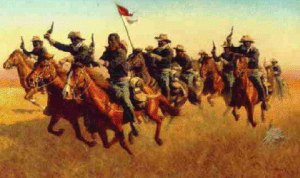Rebecca Partington, Lucy Oppenheimer
 A buffalo soldier was an African-American serving in one of the U.S. Army’s African-American regiments. The term buffalo soldier is derived from an Indian term that described the perceived resemblance between the soldiers’ hair and a buffalo’s head hair. It is unclear whether the term originated in the Cheyenne, Apache, or Kiowa tribe. It is still a matter of contention whether the Indians meant respect or disrespect by using this term.
A buffalo soldier was an African-American serving in one of the U.S. Army’s African-American regiments. The term buffalo soldier is derived from an Indian term that described the perceived resemblance between the soldiers’ hair and a buffalo’s head hair. It is unclear whether the term originated in the Cheyenne, Apache, or Kiowa tribe. It is still a matter of contention whether the Indians meant respect or disrespect by using this term.
The regiments in which the buffalo soldiers served were the 9th and 10th Cavalry Regiments and the 38th, 39th, 40th, and 41st Infantry Regiments. These regiments were created by a reorganization act in 1866, and were meant to recognize African-Americans’ contribution in the Civil War. Despite this, the commissioned officers in the buffalo soldier regiments were almost always white, although there were a few black officers such as Henry O. Flipper.
At first, the buffalo soldiers were posted mainly at isolated frontier forts. They were often illiterate due to being former slaves, and their difficulties were not eased by the army’s failure to provide them with proper supplies. In addition, they were subjected to much racial hostility and sometimes were even victims of violence from white civilians. In the early 1900s, they were assigned labor and service duties rather than combat duties, which might be interpreted as more discrimination against the buffalo soldier regiments.
They were stationed throughout the Southwestern and Great Plains regions of the United States. The buffalo soldiers were involved in conflicts with hostile Indians, Mexican border skirmishes, the Philippine War, and battles in Cuba, and distinguished themselves many times in battle. Six officers and thirteen of the enlisted soldiers earned the Medal of Honor during the Indian Wars. Five more buffalo soldiers earned the Medal of Honor during the Spanish-American War. The buffalo soldier regiments continued to serve until after the Korean War.
The buffalo soldier regiments also served in Yosemite and Sequoia, two of the oldest national parks. One notable buffalo soldier was Captain Charles Young, who was the third black man to graduate from West Point and who, in 1903, began to serve in the 9th Calvary Regiment in Sequoia National Park. In that year he also became the first black superintendent of any American national park.
Buffalo Soldier
During his tenure there, the 9th Calvary built the first trail to the top of Mr. Whitney and the first passable wagon road into the Giant Forest in Sequoia National Park. They also constructed an arboretum, which was the first museum in any American national park. When Young died

